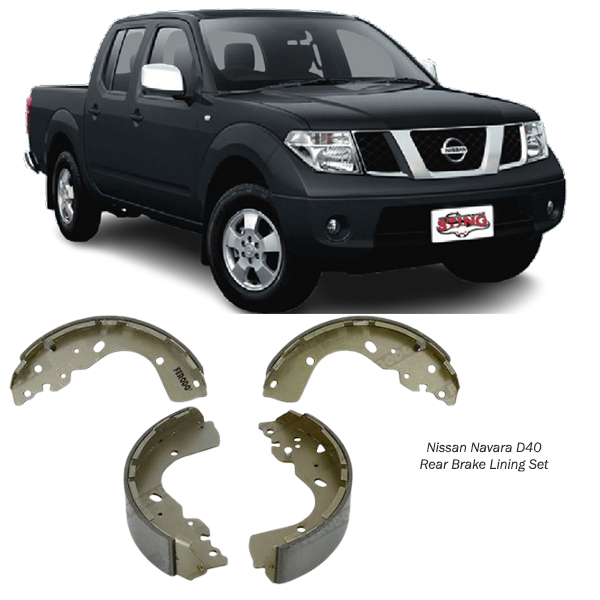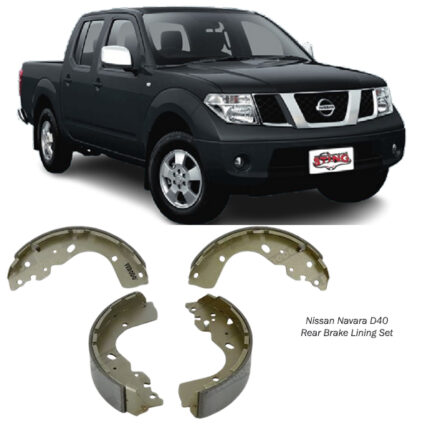-10%
Get Nissan Navara D40 Rear Brake Lining Set 44060-EB327 in Kenya
The Rear Brake Lining Set is an essential part of a vehicle’s braking system, providing the friction required to slow down or stop the vehicle. Brake linings are used in drum brakes, which are often found on the rear wheels of many vehicles, including trucks, some passenger cars, and SUVs. These linings, attached to brake shoes within the drum brake assembly, create the friction necessary to slow down the wheels. The durability, material composition, and maintenance of rear brake linings are vital for safety and vehicle performance.
This guide will provide an in-depth look at the rear brake lining set, its components, materials, function, maintenance tips, signs of wear, and the importance of replacing worn brake linings.
1. Understanding the Rear Brake Lining Set
The Rear Brake Lining Set is part of a drum brake system typically used on the rear wheels. Unlike disc brakes that use brake pads to clamp onto rotors, drum brakes use brake shoes with attached linings that press against the inner surface of a drum. The brake lining set includes several components:
- Brake Linings: The friction material attached to the brake shoes.
- Brake Shoes: The metal backing plates that hold the brake linings in place.
- Return Springs: Springs that pull the brake shoes back after braking.
Together, these components allow the brake shoes to press against the drum when the brakes are applied, generating the friction needed to slow down or stop the vehicle.
2. Components of a Rear Brake Lining Set
The rear brake lining set consists of several parts, each playing a crucial role in the braking process:
a. Brake Linings
The brake lining is a layer of friction material attached to the brake shoe. When the brake shoe is forced outward, the lining contacts the drum’s inner surface to slow down the wheel. High-quality linings are heat-resistant, durable, and designed to create effective friction without excessive wear.
b. Brake Shoes
Brake shoes are semi-circular metal plates that house the brake linings. The shoes press against the drum when the brakes are applied. They are durable and provide a rigid structure for the lining material.
c. Return Springs and Hardware
Return springs pull the brake shoes away from the drum after the driver releases the brake pedal. The springs, combined with other small components like adjusters and pins, ensure the shoes return to their resting position and help prevent premature wear.
d. Wheel Cylinder
In most drum brake systems, the wheel cylinder, which is hydraulic, applies pressure to the brake shoes, pushing them against the drum. It uses brake fluid pressure to transfer the force from the brake pedal to the shoes.
3. Material Composition of Brake Linings
Brake linings are made from materials specifically chosen for their ability to create friction and withstand high temperatures. Common materials used in brake linings include:
a. Organic Materials
These linings are made from natural fibers, resins, and fillers, making them softer and quieter. They are more affordable but wear out faster than other types.
b. Semi-Metallic Materials
Semi-metallic linings contain a mixture of metals, including steel and copper, making them more durable and heat-resistant than organic linings. They offer effective stopping power but may produce more noise and dust.
c. Ceramic Materials
Ceramic brake linings are made from ceramic fibers and nonferrous fillers, which provide excellent heat resistance and durability. They offer smooth braking and are quieter but tend to be more expensive.
Each type has unique characteristics that affect braking performance, durability, and noise levels. The choice of material depends on factors like the vehicle’s size, driving conditions, and desired performance.
4. How the Rear Brake Lining Set Functions
The rear brake lining set operates as part of a hydraulic braking system. When the driver presses the brake pedal, hydraulic fluid flows through the brake lines to the wheel cylinders. The fluid pressure causes the wheel cylinders to push the brake shoes outward against the rotating drum. The friction between the brake linings and the drum slows down the wheels, effectively bringing the vehicle to a stop.
The rear brake linings play a critical role in ensuring effective braking force, especially under load conditions. They allow for safe, controlled stopping distances, particularly when the vehicle is carrying passengers or cargo.
5. Benefits of Rear Brake Lining Sets
Properly functioning rear brake linings offer several advantages for vehicle safety and performance:
a. Enhanced Braking Performance
Rear brake linings contribute to the overall braking force, especially important for larger or heavily loaded vehicles. Quality linings provide consistent stopping power.
b. Reduced Brake Fade
High-quality brake linings help reduce brake fade, a condition where brakes lose effectiveness after repeated use. This is especially important in hilly terrain or stop-and-go traffic.
c. Longer Lifespan of Brake Drums
Good brake linings prevent excessive wear on the brake drum, extending its lifespan. Poor-quality linings may wear down too quickly or create excessive heat, damaging the drum.
d. Improved Safety
Effective brake linings are essential for safe driving, allowing for shorter stopping distances and better control during emergency braking.
e. Noise Reduction
Quality brake linings can help minimize squealing or grinding sounds during braking, contributing to a more pleasant driving experience.
6. Signs of Worn or Damaged Rear Brake Linings
Worn or damaged brake linings can compromise vehicle safety. Recognizing the signs of wear early can prevent more extensive repairs. Here are common indicators of worn brake linings:
a. Squealing or Grinding Noise
A high-pitched squealing sound often indicates worn brake linings. If the lining material wears down completely, the metal of the brake shoe may grind against the drum, causing a grinding noise.
b. Reduced Braking Efficiency
If stopping the vehicle requires more pedal pressure or takes longer than usual, the brake linings may be worn. Reduced braking efficiency can lead to dangerous situations.
c. Vibration in the Brake Pedal
Worn brake linings can cause vibrations in the brake pedal, especially during braking. This may indicate uneven wear or glazing on the lining surface.
d. Visible Wear on Linings
Inspecting the brake linings for wear can help detect issues early. If the lining material looks thin or uneven, replacement may be necessary.
e. Brake Warning Light
Some vehicles have brake warning lights that indicate problems in the braking system. A worn brake lining could trigger this warning.
7. Maintenance and Replacement of Rear Brake Linings
Proper maintenance and timely replacement of rear brake linings are essential for optimal braking performance and safety. Here are maintenance tips for brake linings:
a. Regular Inspections
Regularly inspect the brake linings for wear and damage, ideally every 12,000 to 15,000 miles, or as recommended by the manufacturer. During these checks, look for signs of wear, cracks, or glazing.
b. Brake Adjustments
Some drum brake systems have self-adjusting mechanisms, while others may require manual adjustment. Proper adjustment ensures the brake shoes maintain optimal contact with the drum.
c. Cleaning the Drum and Linings
Brake drums and linings should be kept clean to prevent the buildup of dust and debris, which can affect braking efficiency. Cleaning also helps prevent contamination of the lining material.
d. Replacement of Worn Linings
When brake linings wear down to the minimum thickness, they should be replaced to ensure safe braking. Replacing both sides simultaneously maintains balance and consistency.
e. Avoiding Overloading
Excessive weight can put additional stress on the brake linings, accelerating wear. Avoid overloading the vehicle, as it can cause overheating and damage to the brake system.
8. The Importance of Quality Brake Linings
Investing in high-quality brake linings is essential for several reasons:
- Durability: Quality brake linings last longer, saving money on frequent replacements.
- Performance: Good linings provide consistent braking power, which is especially important in emergency situations.
- Heat Resistance: High-quality materials can withstand high temperatures, reducing the risk of brake fade.
- Noise Reduction: Quality linings are less likely to produce squealing or grinding sounds.
Conclusion
The Rear Brake Lining Set is a critical component of a vehicle’s braking system, designed to provide the friction needed to stop or slow down the car. Regular inspection, maintenance, and replacement of worn brake linings are essential to ensure safe, reliable braking. Investing in high-quality brake linings, understanding the signs of wear, and adhering to recommended maintenance practices can extend the life of the brake system, improve vehicle safety, and contribute to a comfortable driving experience.
Follow us on Facebook for more parts.




